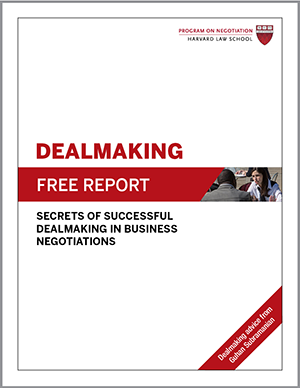
Negotiators are often so intent on preparing for the substance of a negotiation—researching the other party, analyzing their alternatives, and so on—that they neglect to devote adequate time to critical negotiation logistics, such as where to negotiate, how formal or informal talks should be, and even the shape of the negotiating table.
Before the official start of the Group of 7 (G-7) economic conference in Krün, Germany in 2015, U.S. president Barack Obama and German chancellor Angela Merkel took time to tour a historic village and bond over beer and sausages. At the end of their friendly stroll, Obama jokingly asked Merkel whether the G-7 talks might be relocated from a nearby resort to Krün’s charming town center. “It was a very fine beer,” he said as they left the village, according to the New York Times. “I wish I was staying.”
The schmoozing was not only a carefully orchestrated photo opportunity, according to the New York Times, but also a chance, artfully arranged by Merkel, for the two leaders to try to rebuild their previously close bond in the wake of negative press surrounding revelations about intelligence practices between their countries.
It’s too bad that so many negotiators neglect thinking about negotiation logistics, because “process drives substance,” as Harvard Law School professor Robert C. Bordone and Gillien S. Todd wrote in a 2005 Negotiation Briefings article, and as Obama and Merkel’s stroll suggests. In other words, even seemingly minor details can have a powerful impact on how a negotiation unfolds. In this article, we gather advice from past issues of Negotiation Briefings along with new research findings to help you make logistical decisions that will set you up for success.
Negotiation logistics: Here, there, or in the ether?
One of the first process decisions we typically face when planning a negotiation is whether to meet in person, talk over the phone, communicate electronically, or use a combination of these formats.
Optimistic about winning a home-field advantage, most people prefer to negotiate on their own turf, writes Tufts University professor Jeswald W. Salacuse in his book Negotiating Life: Secrets for Everyday Diplomacy and Deal Making (Palgrave Macmillan, 2013). Your familiarity with your office will help put you at ease when facing a challenging negotiation. In addition, when negotiating at home you can control the environment, including the arrangement of the meeting room and how participants are seated. Meeting on your own turf is also more convenient and less expensive.
On the other hand, traveling to your counterpart’s office offers at least two important advantages, according to Salacuse. First, it sends the message that you are a committed partner who is willing to “go the extra mile.” Second, it gives you an opportunity to learn about the other party’s organization and its culture.
So which is better? In their research, Graham Brown of the University of British Columbia and Markus Baer of Washington University in St. Louis found that participants who were given an office to decorate and personalize during the course of an experiment gained a bargaining advantage over their partners, whom they treated like visitors.
“Residents” gained an edge in part because they felt more confident than their “visitors.” Yet, Brown and Baer were able to eliminate the home-field advantage by boosting the visitors’ perceptions of their negotiating skills. The results imply that if traveling to your counterpart’s office makes the most sense, you should be able to level the playing field through proven confidence-boosting measures, such as thinking or writing about a successful past bargaining situation before negotiating.
You might suggest alternating locations to give both parties a chance to learn about the other and demonstrate their commitment. What about meeting on neutral ground, such as a location midway between two parties? Salacuse cautions that this choice limits learning opportunities but also notes it can be smart in dispute resolution, since negotiators might feel pressured or uncomfortable on one another’s turf.
As for negotiating via phone or computer, these choices can be convenient if time or money prevents parties from coming together. But when vocal or visual cues are lacking—as they are in email and phone negotiations, respectively—negotiators tend to have difficulty picking up clear social cues from one another. Misunderstanding, conflict, and wasted time can be the result.
If you must negotiate via email, don’t despair, as it’s been found to have hidden benefits. Email allows parties to overcome time differences by negotiating whenever they like. It also lowers language barriers by allowing negotiators to revise their messages. And email minimizes power differences between negotiators, likely because the trappings of power are not evident in electronic communications. When negotiating via email, you can greatly improve your odds of agreement by preceding substantive “talks” with a friendly phone conversation, Northwestern University professor Janice Nadler has found.
Negotiation logistics: What type of table?
In the stereotypical team negotiation, the two sides glower at one another from across the table. Unfortunately, this stereotype often plays out in real life. Harvard Law School and Harvard Business School professor Guhan Subramanian describes how two factions of a Fortune 500 board, divided on a contentious issue, gravitated to opposite sides of the table at the start of an all-day meeting. Midway through, one of the board members commented that the conversation felt like a battle as a result of their seating choices, Subramanian wrote in the May 2011 issue of Negotiation Briefings.
You may be able to promote a more problem-solving approach by arranging for negotiators from different teams or factions to be interspersed around the table, perhaps by setting out name cards in advance. Similarly, when meeting with just one counterpart, consider a seating area away from any desk or table that might serve as a physical and symbolic barrier.
Should you take notes on your computer during your negotiations? In a study, Pam A. Mueller of Princeton University and Daniel M. Oppenheimer of the University of California, Los Angeles, had a group of students take notes at a lecture. Those who used pen and paper scored significantly higher on a subsequent comprehension test than those who typed on their laptops. It seems those using laptops mindlessly typed what they heard, whereas those writing longhand synthesized as they wrote in a way that led to deeper absorption. In negotiation, there might be another reason to write longhand: An opened laptop could become a barrier between negotiators, if each wonders what the other is looking at or typing.
Negotiation logistics: Should you chitchat?
Obama and Merkel’s stroll through Krün highlights the potential benefits of taking time to build rapport at the start of a negotiation. Here, context matters. If your counterpart quickly ushers you to a chair in her office, she may be irritated by your attempts to build rapport, but if she offers you coffee first, she may have more of an inclination toward small talk. When you are the host, of course, you can signal your openness to rapport building through such subtle choices.
Negotiation logistics: Should you eat, drink, and be merry?
The Obama-Merkel stroll raises a related question: Should you negotiate over a meal (even if it’s just brats and beer) or keep talks more businesslike?
In one study, Stanford Graduate School of Business professor Margaret Neale and doctoral student Peter Belmi gave some pairs of study participants food to share, such as chips and salsa, while they negotiated; other pairs were given individual portions of the same food. The results showed that shared food, but not individual portions, helped negotiators who had been told they were facing a competitive situation create value. Surprisingly, however, those who were told they were facing a cooperative situation created less value when given food to share.
Neale and Belmi theorized that shared food broke down barriers between potential competitors but led negotiators who expected a cooperative mood to become more concerned with maintaining their relationship than with reaching a great agreement. Thus, when upcoming negotiations are likely to be tense or competitive, you might serve food meant for sharing but forego meals—or serve individual portions—when negotiating with someone you know well.
What about that beer Obama enjoyed with Merkel? Alcohol consumption can lead to impaired judgment, simplistic thinking, excessive confidence, strong emotions, and aggressive, competitive behavior. Moreover, when you offer alcohol during a negotiation, you risk offending counterparts who may have moral, religious, health, or legal reasons for abstaining, write Adam D. Galinsky and Maurice E. Schweitzer in their July 2007 Negotiation Briefings article “Negotiators: Think Before You Drink.”
Yet many negotiators have built bridges over a friendly drink or two. If you think your counterpart would be receptive to imbibing with you, follow Merkel’s lead and separate the relationship-building stage of the negotiating process from the bargaining stage, advise Galinsky and Schweitzer. In addition, to ward off alcohol’s negative effects, make sure food and water are available, and place time limits on your happy hour.
Should you negotiate logistics?
When you’re hosting a negotiation, it can be tempting to make process decisions unilaterally. After all, why cede control when you don’t have to? Moreover, when parties are at odds, “endless haggling about ‘the shape of the table’ can consume valuable time,” Harvard Business School professor James K. Sebenius wrote in a 2006 Negotiation Briefings article.
On the other hand, you are likely to increase your counterparts’ perceptions that the negotiation is fair when you involve them in logistical decisions. In addition, offering concessions on logistical issues that you don’t feel strongly about may inspire the other party to reciprocate on issues that matter more to you.
The answer to this question may be to take each negotiation and decision on a case-by-case basis, considering both the context and the individuals involved.





Fantastic insights on negotiation logistics! This article offers valuable strategies for securing better deals through effective planning and execution.
these are some really interesting insights into the negotiation especially with geopolitical context. thanks for sharing!
Interesting article. From my own experience, I’d suggest that the ‘home turf’ confers a definite advantage – but only for incoming negotiators who are not on their brief and not prepared. Sometimes, in fact, that home turf feeling can lead to complacency and uncertainty when faced with a disruptive challenge. I think also the article perhaps overlooks that the ‘two leaders having a stroll and a shared meal’ is a carefully curated event that is more of a political-cultural expectation than an attempt to leverage advantage. Of course, any and everything can exert a framing influence on a negotiation (whether intended or otherwise) – but it’s worth noting that there will be many other perspectives and interests intruding on the scenario than just Obama and Merkel’s.
Since part of the MGA advices for difficult negotiations is to seriously consider the person of an independent facilitator or mediating chair, I missed the extra advantage that provides for location and other logistic preparations. Since I have worked as an independent chair for 20 years, I know how important my and my team’s influence turned out to be. Former minister and top McKinsey consultant Pieter Winsemius wrote a book called: Never play an away game! Although we both were very succesful in getting agreements by visiting ministers in other countries.